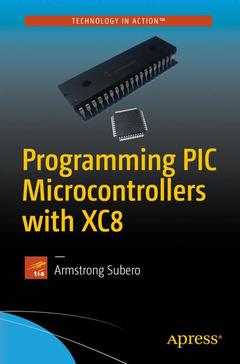Programming PIC Microcontrollers with XC8, 1st ed.
Auteur : Subero Armstrong

- Set up the MPLAB X and XC8 compilers for microcontroller development
- Use GPIO and PPS
- Review EUSART and Software UART communications
- Use the eXtreme Low Power (XLP) options of PIC microcontrollers
- Explore wireless communications with WiFi and Bluetooth
Date de parution : 12-2017
Ouvrage de 434 p.
15.5x23.5 cm
Mots-clés :
Microcontrollers; Moving from Arduino; PIC Microcontroller; PIC Microcontroller Projects; Microcontroller Tutorials; Programming PIC Microcontrollers; Using bare Microcontrollers; Microcontroller for Beginners; How to get Started with PIC microcontrollers?; Embedded Systems; Buliding Embedded Systems Program PIC microcontroller in C



